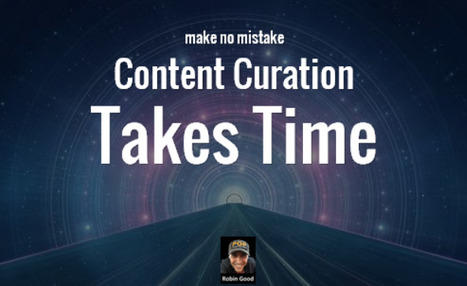 Your new post is loading...
 Your new post is loading...
We’re only a few months out from the roaring 2020s, and you know what that means: it’s marketing budget season! Across the nation, marketers from companies big and small are putting their plans in place to kick off a stellar year of growth. With more tactics available to marketers, it can sometimes feel like a tricky proposition to choose which marketing channels you should dedicate your budget too. However, there’s one marketing tactic that no marketer should ignore in 2020 – content marketing. Here are five 2020 content marketing trends to make sure your strategy is aligned with the year ahead.
Via Brian Yanish - MarketingHits.com
People have been using stories as a way to transfer knowledge. The practice had such a profound effect on us that, even today, we find it hard to turn away from story-driven content. Here are 5 tips for using storytelling in content marketing
Via Daniel Watson
Do you want to automate your content curation? All you have to do is follow the steps below. Step #1: Follow people within your industry on Twitter – once you follow people in your industry you will see what’s hot. This way you don’t have to browse the web and search around for what’s hot.Step #2: Use Pocket – this will allow you to favorite and save what you have found on Twitter that you like. That way, as you are reading you can save what you like.Step #3: Schedule out the content using Buffer – you can connect Pocket to your favorite social media scheduling tool and then schedule out all of the content you like.The content will then get pushed out on your Twitter, Facebook, LinkedIn and any other social site you use....
Via Jeff Domansky
Is it possible to narrate a story with social media posts that are supposed to be short and sweet? Yes! Here're 20 creative social media storytelling ideas.
Breaking the Top 10 storytelling posts for 2016 into two parts, I published the first part last week.
Here’s the second part, again reflecting the varied facets that make up today’s communications in the business world.
In spite of the massive changes in our industry, media relations and PR storytelling still matter, an apt way to kick off the rest of the list....
Via Jeff Domansky
Aggregate social media posts, measure audience engagement and publish custom content feeds for your campaigns, websites and events. Get more from your social content Create custom feeds, measure audience engagement, monitor the competition and publish aggregated content to websites, displays or live events. Aggregate social content Add any @account or #hashtag from Twitter or Instagram to instantly build a custom feed. Monitor your brand and audience, follow #hashtags or keep an eye on the competition....
Via Jeff Domansky
These days, it’s no secret that high-quality images are important for any marketing strategy, particularly when it comes to social media. Images not only help brands stand out in busy social news feeds, but they also boost engagement and build brand awareness—and their importance is growing.
According to a WebDAM infographic, 84% of all communication will be visual by 2018. So, there’s no better time than the present to ensure you’re creating and sharing top-notch imagery. And that starts with following sizing best practices for each channel.
To help you do just that, below is a quick cheat sheet for sizing your images for optimal impact, complete with dimensions and some examples. In addition, you’ll also find some helpful tools that can help your resize, edit or create images....
Via Jeff Domansky
When emotionally-charged content is placed in front of the right audience, it can spread at an incredible rate. We recently had this happen with a Fractl client campaign called Perceptions of Perfection, which we executed for Superdrug Online Doctor.
Here’s a look at the results during the first few days of the campaign launch...
Via Jeff Domansky
Content Curation Takes Time
Creativity and great ideas can be dosed in a masterly way of aninfographic. Those 14 infographics is proof of that. They are tremendously useful information, it does so with full creativity and originality. Although most of them are about web design, some of those is also for SEO professionals or graphic designers themselves. I recommend you take a look at them because from the visual and composition view are very well developed....
Via Jeff Domansky
Unfortunately, there is no one magical solution to mastering your brand’s online presence, but there are a few ways you can revitalize it. The first? Content creation. As described in this graphic by the folks at Rebuild Nation, these are original posts centered around what your business offers. They can be in the form of promotions or even daily deals. Another vital component of a successful online strategy is content sharing. These are informative posts aimed to engage your followers. These can include links to third party sites, trending news, etc....
Via Jeff Domansky
|
AI tools support marketers in every marketing stage, from ideating to strategizing and publishing content. You can improve your current marketing efforts and customer experience with AI content creation tools. Even predicting the future of business is possible with AI! Deploy a chatbot or gather sufficient past customer data to extract valuable insights about buyer behavior and formulate marketing campaigns that align with the information.
With AI learning and growing every day, your business is set on the path to flourish and scale tremendously one day at a time. All brands must continue to leverage the full benefits of AI and human intelligence and labor in their marketing efforts to reach the right audience at the right time. Learn more / En savoir plus / Mehr erfahren: https://www.scoop.it/t/21st-century-learning-and-teaching/?&tag=Content+curation https://www.scoop.it/topic/21st-century-learning-and-teaching/?&tag=content+marketing
Via Gust MEES
Everyday, there are 4 million blog posts, 100,000 news articles and 500,000 hours of video published on the Internet. A wealth of information and knowledge. A wealth of information and knowledge that is lost for most companies, at least for the most part.
Lost?
Step 1: content curation
Not entirely. Thanks to content curation technology, the Web can now be filtered. With content curation tools and platforms such as Scoop.it (among others of course), we can use more or less sophisticated ways to filter this huge amount of content that is published daily to zoom in on what matters to us. Good content curation technology is essential. It saves people a huge amount of time looking for content to share for marketing purposes or information that helps their organization make better decisions. And perhaps as importantly, without these filters, we would just be able to search – not discover. We would still find answers to what we don’t know but we wouldn’t know what we don’t know.
But until recently, all the solutions we’ve offered to deal with information overload – ours included – have revolved around the same basic idea: more – or more sophisticated – filters. Learn more / En savoir plus / Mehr erfahren: https://www.scoop.it/t/21st-century-learning-and-teaching/?&tag=Curation
Via Gust MEES
So you want to do content marketing – and in a big way. This isn’t going to be a tentative test. You’re making an aggressive, committed, all-in push to create and engage an audience for the long-term.
First of all – good for you! Content marketing is effective, and increasingly more effective than advertising. And as it gets harder and harder for advertising to work, we expect more companies to make serious, committed shifts like this.
But now that you know you’re serious, you’re going to need to hire people. This assumes, of course, that you’ve decided to keep this thing in-house rather than hire an agency.
I think that’s smart. Here’s why:
Good content marketing involves the entire company – sales, customer service, management, even accounting and development. An in-house team will always have better communication channels with those departments than an agency will. You’ll see each other in the elevator, at the Christmas party, and at any other company-wide function.
There’s no question of everyone being “on the team” with an in-house content program. This isn’t always so with agencies. There are sometimes lingering questions about what an agency’s priorities really are.
Great content marketing rises up from your company’s DNA. Your brand voice, your value proposition, your understanding of your customers… these are so core to your company that I worry about hiring an agency to define it for you.
With the agency thing settled, you now need to go build your team. The question becomes: What are your goals? What’s your budget? Those answers will inform how big of a team you’ll need and who you’ll hire first.
Learn more / En savoir plus / Mehr erfahren: https://www.scoop.it/t/21st-century-learning-and-teaching/?&tag=press https://gustmees.wordpress.com/2014/02/26/curation-the-21st-century-way-to-learn-on-its-own-pace-and-to-organize-the-learning/
Via Gust MEES
You don’t have to wait months or years to get high rankings in Google. Through Google News, you can instantly shoot up to page 1 of Google.
Now Google already gives you a set of guidelines, but here is what I found is effective:
1. You have to write news worthy content – if you are struggling to find news content you can go to Google Trends or any popular news site to see what’s hot.
2. Create a Google News Sitemap – through the Yoast SEO plugin you can create a sitemap. This way when you have news worthy content they will pick it up faster.
3. Your URL structure has to be unique – if you don’t have news related keywords within your URL you are less likely to rank. By having specific keywords you will shoot up to the top for news related queries.
In addition to that, follow the guidelines Google News gives and you will be fine.
Via Jeff Domansky
If you’re working to build up your social media presence, you know that images are essential to boosting your online engagement. In fact, content with images gets almost twice as many views. If you’re not sharing images your audience loves, you’re missing out on serious engagement.
You need visual content, but figuring how to get it can be a challenge.
Which images are best for your business?How can you find or create them?How can your images stand out among the avalanche of others on social media when Facebook alone sees more than 300 million images shared every single day?
In this post, you’ll get three great tips on how to up your social game so you can get more clicks, likes and follows. You’ll learn the elements of shareable images, what works on each platform, and design tips to create engaging images for social media....
Via Jeff Domansky
Why content curation? First off, you’re likely already doing it in some capacity. According to Curata, more than 83% of marketers curate and share content from third party sources with their customers or prospects. Secondly, content curation can add value, quality and credibility to your content marketing efforts and your brand. Curata also reports that over 50% of marketers say content curation has increased their brand visibility, thought leadership, SEO, web traffic and buyer engagement, and 41% of marketers say the number of quality or sales-ready leads increased, too. Finally, as previously mentioned, content creation allows you to create quality, compelling content in less time. As TopRank Marketing’s CEO Lee Odden wrote in his book Optimize: “Pure creation is demanding. Pure automation doesn’t engage. Curating content can provide the best of both.” Whether you’re thinking about adding content curation to your tactical mix or looking for ideas to boost the quality of your curation efforts, below we offer some best practices, tips, tool suggestions and some examples of how brands are doing it....
Via Jeff Domansky
In a platform world, publishers face tough decisions on where to place their resources. In August, The Economist faced this head on and axed its ailing Pinterest and Tumblr accounts while ramping up its commitment to LinkedIn.
The publisher had been experimenting on Pinterest for the past six months. But even with a social media team that had grown from two to 10 people, The Economist couldn’t make it click. “From day one, it was a struggle,” said Denise Law, community editor at The Economist. “We found it difficult to articulate what our raison d’être for Pinterest was. It’s not the place to share serious content; it’s more where people go to share ideas.”
For Pinterest, The Economist was posting pieces from 1843, its culture and lifestyle magazine, then called Intelligent Life. Articles from travel blog Gulliver’s Travels were also going there, as well as pieces from its archives and links to items from The Economist Store. But it was gaining no traction. When it cut the account, it had 5,000 followers. “Not enough to move the needle,” said Law, adding that its Tumblr account shared the same fate. Earlier this year, The Economist also culled a number of its Twitter accounts.here's
The Economist’s approach to social media is, according to the publisher, to promote quality over quantity. It’s taken that mission to LinkedIn, which it uses for brand awareness rather than to drive traffic. By tweaking its approach to publish a broader spectrum of content, The Economist saw its LinkedIn follower count grow from half a million last year to 2.4 million, and it continues to grow at a rate of 25,000 followers a week, according to Law....
Via Jeff Domansky
How do you make effective, engaging content that gets people to take action? Take some lessons from Carlos Abler, leader of content marketing strategy for 3M Global eTransformation. At the Intelligent Content Conference, Carlos demonstrated how personalized content can not only change behavior but also transform lives.
In his presentation about a University of Michigan case study, he described how a six-week program of personalized online content reduced smoking and increased healthy behaviors for the young adults who were enrolled in the study....
Via Jeff Domansky
Content Curation Takes Time
With the roll-out of our new Facebook contest category and the growing importance of social media design overall, we thought it was about time to focus on the different elements that make up Facebook design.In this article, we’ll break down the different elements of Facebook to ensure that you’re creating a well-branded and clickable web presence for your client....
Via Jeff Domansky
Great storytelling is a great differentiator.
Imagine you're walking down the snack aisle at a grocery store. How do you make sense of the hundreds of choices on either side of you? What's going to be on your mind when you decide what to buy? Perhaps you choose one product over another because that company donates a percentage of their proceeds to a great cause. Or maybe you choose it because it has more protein -- and you were just reading this article about how protein helps boost concentration, and you've been having trouble concentrating at work recently.
People like making decisions quickly, and it'll be easier for them to choose your stuff if your message resonates with them. After all, content helps people travel through the inbound marketing methodology so that, someday, they might buy something from your company and spread your company's story with others.
But, as you may have noticed, a lot of people are trying to tell stories these days. How are you going to set yours part from the pack? And where on earth do you begin creating compelling stories for your brand?...
Via Jeff Domansky
|



 Your new post is loading...
Your new post is loading...

































![A Visual Guide to Telling Compelling Stories for Your Brand [Infographic] | Education 2.0 & 3.0 | Scoop.it](https://img.scoop.it/bdgdY0H6lziC8cidQvoRtTl72eJkfbmt4t8yenImKBVvK0kTmF0xjctABnaLJIm9)







Writing well-researched content containing over 1,200+ words is often a requirement to gain a higher position in Google search results. When trying to score more points with SEO, web writers often forget that it’s not a search engine that reads posts, but a human being.
Learn more / En savoir plus / Mehr erfahren:
https://gustmees.wordpress.com/?s=curation
https://gustmees.wordpress.com/?s=blogging
https://globaleducationandsocialmedia.wordpress.com/2014/01/19/pkm-personal-professional-knowledge-management/
https://www.scoop.it/topic/21st-century-learning-and-teaching/?&tag=Blogging
https://www.scoop.it/topic/21st-century-learning-and-teaching/?&tag=content+marketing